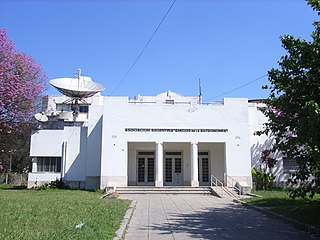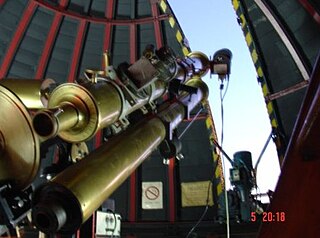 W
WThe Argentine Institute of Radio Astronomy (IAR) was created in 1962 through an agreement between the scientific agencies CONICET and CIC, and the universities of La Plata and Buenos Aires. Its functions are to promote and coordinate the research and technical development of radio astronomy in Argentina and to collaborate in the teaching and dissemination of astrophysics and related disciplines. The Institute continues its activities in the dependency of the National Council of Scientific and Technical Research (CONICET), the Commission of Scientific Research of the Province of Buenos Aires (CICPBA) and the National University of La Plata (UNLP). Its current director is Dr. Gustavo E. Romero and its deputy director, Dr. Jorge A. Combi.
 W
WThe Argentine National Observatory, today the Astronomical Observatory of Córdoba, was founded on 24 October 1871, by Argentine president Domingo F. Sarmiento and the North American astronomer Benjamin Apthorp Gould.
 W
WAsociación Argentina Amigos de la Astronomía is an amateur astronomy civil association based on Buenos Aires, Argentina, with the aim of spreading astronomy. It was founded on January 4, 1929 and its field courses are held on related subjects, research in collaboration with professional bodies and printed publications or multimedia, and recreational activities for the general public. The main-belt asteroid 4756 Asaramas was named in honor of the observatory.
 W
WAstrodomi observatory is an astronomical observatory located in Tigre, Buenos Aires Province, Argentina. It has observatory code I37.
 W
WFélix Aguilar Observatory is an astronomical observatory. It was established in 1953, in San Juan Province, Argentina. In 1974, it was renamed to Carlos Ulrrico Cesco Astronomical Station.
 W
WThe Galileo Galilei planetarium, commonly known as Planetario, is located in Parque Tres de Febrero in the Palermo district of Buenos Aires, Argentina.
 W
WThe Large Latin American Millimeter Array (LLAMA) is a single-dish 12 m Nasmyth optics antenna which is under construction in the Puna de Atacama desert in the Province of Salta, Argentina. The primary mirror accuracy will allow observation from 40 GHz up to 900 GHz. It is also planned to install a bolometer camera at millimeter wavelengths. After installation it will be able to join other similar instruments to perform Very Large Base Line Interferometry or to work in standalone mode. Financial support is provided by the Argentinian and Brazilian governments. The total cost of construction, around US$20 million, and operation as well as the telescope time use will be shared equally by the two countries. Construction planning started in July 2014 after the formal signature of an agreement between the main institutions involved.
 W
WThe El Leoncito Astronomical Complex is an astronomical observatory in the San Juan Province of Argentina. CASLEO is one of two observatories located within El Leoncito National Park, which is in a part of the country which rarely sees cloud cover. The other facility in the park is the Carlos U. Cesco Astronomical Station of the Félix Aguilar Observatory. CASLEO was established in 1983 by an agreement between National Scientific and Technical Research Council (CONICET) of Argentina, the Ministry of Science, Technology and Innovation (MINCYT) of Argentina, the National University of San Juan (UNSJ), the National University of La Plata (UNLP), and the National University of Córdoba (UNC). The facility was dedicated in 1986 and regular observations began in 1987.
 W
WThe Pierre Auger Observatory is an international cosmic ray observatory in Argentina designed to detect ultra-high-energy cosmic rays: sub-atomic particles traveling nearly at the speed of light and each with energies beyond 1018 eV. In Earth's atmosphere such particles interact with air nuclei and produce various other particles. These effect particles (called an "air shower") can be detected and measured. But since these high energy particles have an estimated arrival rate of just 1 per km2 per century, the Auger Observatory has created a detection area of 3,000 km2 (1,200 sq mi)—the size of Rhode Island, or Luxembourg—in order to record a large number of these events. It is located in the western Mendoza Province, Argentina, near the Andes.
 W
WThe La Plata Astronomical Observatory is an observatory located in the city of La Plata, capital of the province of Buenos Aires, Argentina. Its IAU code is 839.
 W
WThe POlarization Emission of Millimeter Activity at the Sun (POEMAS) is a solar patrol system composed of two radio telescopes with superheterodyne circular polarization receivers at 45 and 90 GHz. Since their half power beam width is around 1.4°, they observe the full sun. The acquisition system allows to gather 100 values per second at both frequencies and polarizations, with a sensitivity of around 20 solar flux units (SFU) (1 SFU ≡ 104 Jy). The telescope saw first light in November 2011, and showed excellent performance during two years, when it observed many flares. Since November 2013 is stopped for repairing. The main interest of POEMAS is the observation of solar flares in a frequency range where there are very few detectors and fill the gap between microwaves observed with the Radio Solar Telescope Network (1 to 15.4 GHz) and submillimeter observations of the Solar Submillimeter Telescope (212 and 405 GHz). Moreover, POEMAS is the only current telescope capable of carrying on circular polarization solar flare observations at 90 GHz. (Although, in principle, ALMA band 3 may also observe at 90 GHz with circular polarization).
 W
WThe St. Joseph Observatory (OSJ) is an amateur astronomy observatory located in Buenos Aires, Argentina. It was founded in 1913. It was initially constructed on 1870 and for being the tallest building was declared ideal observatory of Balvanera neighborhood. It is the first astronomical observatory in Buenos Aires which still remains in activity. Currently performs research and recreational activities for the public as courses or seminars.